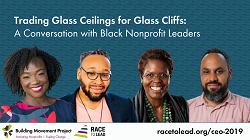Mar
2
2022
Quick Access: watch the full webinar recording, read the transcript, and download the report
Last week the Building Movement Project hosted a national webinar where Sean Thomas-Breitfeld (Co-Executive Director) unpacked the findings of our latest report on nonprofit executives of color and moderated a panel discussion with Karundi Williams (re:power), Margaret Mitchell (YWCA USA), and Prentiss Haney (Ohio Organizing Collaborative).
The report, Trading Glass Ceilings for Glass Cliffs: A Race to Lead Report on Nonprofit Executives of Color, focuses on the experiences and challenges facing nonprofit leaders of color. In addition to data and testimonials, it includes five key findings:
- Leaders of color need supports, not more training.
- Leaders of color take on added burdens, without additional compensation.
- Leaders of identity-based organizations face distinct demands.
- Unique challenges come with taking over leadership from white leaders.
- Too few white leaders factor race equity into their succession plans.
Following a presentation of the data and findings, Sean turned to the panelists to hear their reactions to the report and insights on how to live into one’s values while leading, navigate imposter syndrome, build a strong nonprofit board, and more. Read on for highlights from the discussion.
Karundi Williams on funding racial justice work and supports for people of color:
There’s not a lot of changes that we’re seeing in terms of funding flowing to Black-led organizations. We are seeing a lot of people of color, program officers of color, and more Black women in leadership roles within philanthropy. I think that could make a huge difference, and that trend has to continue. I think as a movement, we need to figure out a strategy that puts more people that look like us in these rooms that are making decisions about resources flowing to organizations that are Black-led and to work that is [focused on] racial justice or racial equity.
I think as leaders – and I can speak from my experience – having unapologetic, authentic conversations with funders is really important. I was not shy about saying exactly what I needed. There’s an approach about calling in your funders to really partner with you in a really deep way, to support what it is that you’re trying to build. There is a lot of conversation in philanthropy right now about supporting racial justice work and supporting Black leaders. I think there’s an accountability in that that we need to ask: How are you actually living into these big statements of supports for people of color?
Prentiss Haney on co-leading an organization and making difficult decisions:
What I’ve been able to see in this role is that I have to be the steward of innovation. I have to be the person that has the calm steady hand to “hospice” things that no longer serve us. And when you are in that leadership and [are] young, you have to have a wise soul to move those things forward. But wisdom comes from listening and seeing where you can get a kernel of truth from everyone who is putting something in it. Wise leadership is not about age, it’s about the ability to listen and see what’s out there in the world. I’ll talk about hospice and stewarding. So, hospice is literally taking a gentle hand to allow what no longer serves the organization to leave. And also, while you’re “hospicing,” you have to also be laying the foundations for a new culture. And that’s where the stewarding helps, because you bring some of the old pieces in, you bring in new pieces. And then the third part of this, after you hospice and steward, is you have to midwife the new. You have to literally allow the rebirth in the organization to come. And that birth is something that has to be grown and invested and tended to.
Margaret Mitchell on confronting imposter syndrome as a leader of color:
We are un-brainwashing. We are unwinding our own crazy tapes in our brain. We are dismantling worldviews, regardless of your color, the body you’re in. What I say typically to my team and young staffers is: “You do you.” You can’t ever be an imposter of you. It’s just not physically possible. The more you continue to like you, to be you, to be in the body. All of those imposter syndromes, it’s just a trap. It’s just a trap that we often allow that tape to be playing. And as it plays, we have to often learn how to use it for us and not against us. Certainly, I can never say that I didn’t struggle. But as I have continued to grow over the years in being comfortable with who I am, that is always just about that intellectual curiosity around discovery, and the discovery of yourself.

